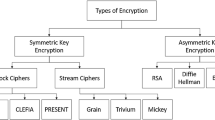Abstract
To improve the robustness to combined attack of signal processing plus tamper, a composite chaos-based lossless scheme for image authentication and tamper localization is proposed. A non-successive composite chaos (NSCC) is described, and its performance is analysed by some evaluation indicators. Then NSCC is employed to disturb original image and generate chaotic logo, which enhances the security and robustness of lossless image authentication scheme due to the good performance of NSCC in these aspects of randomness, complexity and ability of anti-forecast technology. Experimental results demonstrate that the proposed scheme is not only safe, but also realizes the correct extraction of logo and precise detection of tampered region position and shape under various attacks, especially signal processing plus tamper attack.














Similar content being viewed by others
References
Chen G, Lai D (1996) Feedback control of Lyapunov exponents for discrete-time chaotic dynamical systems. Int J Bifurc Chaos 6:1341–1349
Chen G, Lai D (1997) Making a dynamical system chaotic: feedback control of Lyapunov exponents for discrete-time dynamical systems. IEEE Trans Circ Syst I 44(3):250–253
Chen SY, Leung H (2008) Chaotic watermarking for video authentication in surveillance applications. IEEE Trans Circuits Syst Video Technol 18(5):704–709
Giakoumaki A, Pavlopoulos S, Koutsouris D (2006) Multiple image watermarking applied to health information management. IEEE Trans Inf Technol B 10(4):722–732
Huang X, Yi M, Susilo W (2011) Preserving transparency and accountability in optimistic fair exchange of digital signatures. IEEE Trans Inf Forensic Secur 6(2):498–512
Mao L, Fan Y, Wang H, Lv G (2011) Fractal and neural networks based watermark identification. Multimed Tools Appl 52:201–219
Pincus SM (1995) Approximate entropy (ApEn) as a complexity measure. Chaos 5(1):110–117
Poljicak A, Mandic L, Agic D (2011) Robustness of a DFT based Image watermarking method against AM Halftoning. Teh Vjesn 18(2):161–166
Radu OP, Dragos NV (2011) Robust wavelet-based video watermarking scheme for copyright protection using the human visual system. J Electron Imaging 20:013022-1–013022-11
Rawat S, Raman B (2011) A chaotic system based fragile watermarking scheme for image tamper detection. AEU-Int J Electron C 65(10):840–847
Rukhin A, Soto J, Nechvatal J. A statistical test suite for random and pseudorandom number generator for cryptographic applications. http://csrc.nist.gov/rng/
Sun FY, Lu Z (2011) Digital image encryption with chaotic map lattices. Chinese Phys B 20(4):040506-1–040506-7
Tian L, Zheng N, Xue J (2011) An integrated visual saliency-based watermarking approach for synchronous image authentication and copyright protection. Signal Process-Image 26(8):427–437
Tong X, Cui M (2009) Image encryption based on disturbed composite chaos. Sci China-Inform Sci 39(6):588–597
Walton S (1995) Information authentication for a slippery new age. Dr Dobbs J 20(4):18–26
Yuen C, Wong K (2012) Chaos-based encryption for fractal image coding. Chinese Phys B 21(1):010502-1–010502-12
Zhang LH, Liao XF, Wang XB (2005) An image encryption approach based on chaotic maps. Chaos Soliton Fract 24(3):759–765
Zhang J, Xiao X (2000) Predicting low-dimensional chaotic time series using Volterra adaptive filters. Acta Phys Sin 49(3):403–408
Zhang S, Xiao X (2005) A new method of global prediction for chaotic time series based on continued fractions. Acta Phys Sin 54(11):5062–5068
Acknowledgment
This research is supported by the Natural Science Foundation of Educational Commission of Jiangxi Province of China under Grant GJJ12614.
Author information
Authors and Affiliations
Corresponding author
Rights and permissions
About this article
Cite this article
Gao, G. Composite chaos-based lossless image authentication and tamper localization. Multimed Tools Appl 63, 947–964 (2013). https://doi.org/10.1007/s11042-012-1329-0
Published:
Issue Date:
DOI: https://doi.org/10.1007/s11042-012-1329-0




